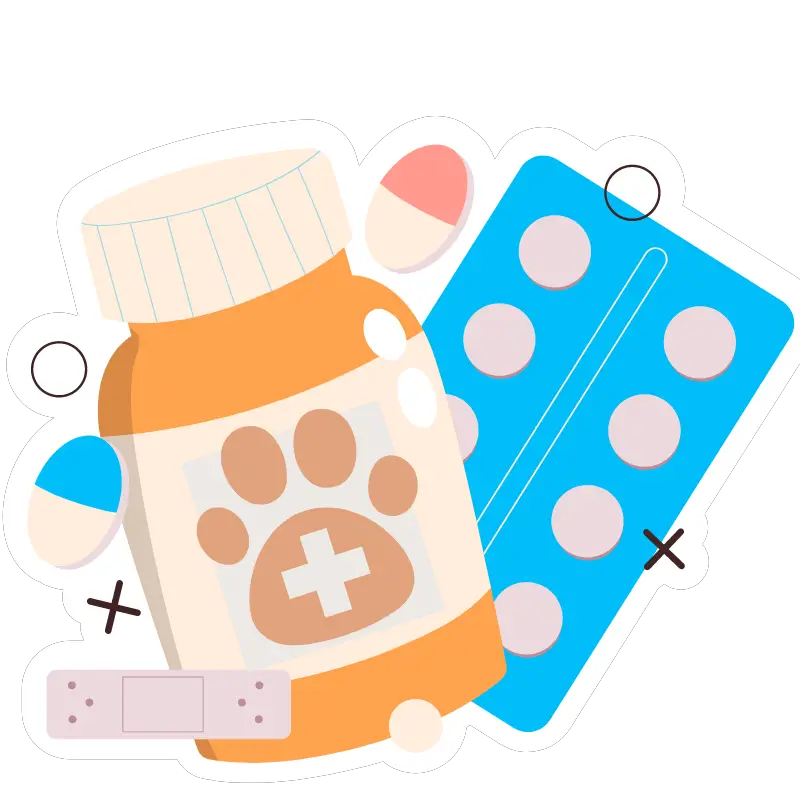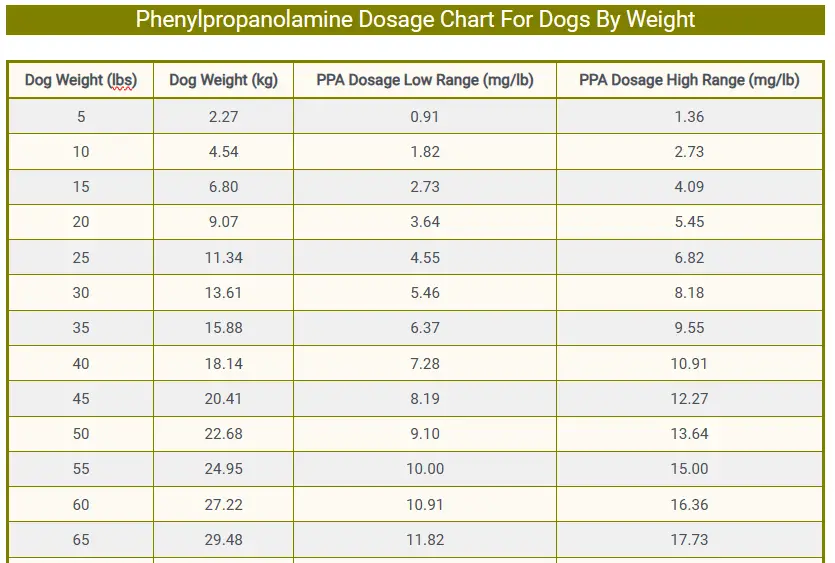The veterinarian recommended dosage of Phenylpropanolamine for treating urinary incontinence in dogs is 1 to 1.5 mg/kg (0.4-0.6 mg/lb). However, the dosage of the medication can be adjusted, either increased or decreased, based on the severity of the urinary incontinence.
Phenylpropanolamine Dosage For Dogs

-
Ideal Dose: 1-1.5 mg/kg (0.4-0.6 mg/lb).
-
Uses: For treating urinary incontinence in dogs.
-
FDA Approved: Proin® is an FDA approved.
-
Common Brand Names: Proin®, Propalin®, Cystolamine®, Uricon®, Uriflex-PT®
-
Variants: Tablets, Liquid.
-
Storage & Handling: Room Temperature.
-
Administration: Every 8 to 12 hours.
Disclaimer: Self-medication can be hazardous. Please consult your veterinarian for personalized guidance on the appropriate dosage for your furry friend’s specific condition.
When it comes to our furry companions’ health, responsible pet owners are often vigilant about ensuring they receive the best care possible. Whether it’s for managing allergies, controlling weight, or treating urinary incontinence, medications can play a crucial role in maintaining a dog’s well-being.
One such medication that veterinarians frequently prescribe is phenylpropanolamine (PPA). However, determining the correct dosage of PPA for dogs requires careful consideration of various factors to ensure both safety and effectiveness.
In this guide, we’ll delve into the nuances of phenylpropanolamine dosage for dogs, shedding light on its uses, potential side effects, and the importance of consulting with a trusted veterinarian for tailored advice.
What Is Phenylpropanolamine For Dogs?
Phenylpropanolamine (PPA) is a medication that is commonly used to treat urinary incontinence in canines, especially in spayed females. It works by tightening the bladder sphincter muscle, which helps control urine leakage.
However, PPA has been associated with some severe side effects, including increased blood pressure and stroke in both humans and animals.
Due to these risks, the use of PPA in veterinary medicine has declined significantly, and in many countries, it has been withdrawn from the market entirely.
If your dog is experiencing urinary incontinence, it’s essential to consult with your veterinarian to explore safer and more effective treatment options.
They can guide the best course of action based on your dog’s individual needs and health status.
Phenylpropanolamine Dosage For Dogs
Dosages of phenylpropanolamine for dogs varied depending on factors such as the dog’s weight, the severity of the condition being treated, and the specific formulation of the medication. Typically, PPA was available in tablet form in strengths ranging from 25 mg, 50mg to 75 mg.
For urinary incontinence, a typical starting dosage might have been around 1 to 1.5 mg/kg (0.4-0.6 mg/lb) of body weight given orally every 8 to 12 hours. However, dosages could be adjusted based on the dog’s response to treatment and any side effects observed. It’s crucial to follow the veterinarian’s instructions carefully and to stay within the prescribed dosage with their guidance.
Please note that FDA has withdrawn approval for the use of PPA in both human and veterinary medicine due to concerns about its safety, particularly regarding its potential to increase the risk of strokes.
Phenylpropanolamine Popular Brand Names For Canines
-
Proin®
-
Propalin®
-
Cystolamine®
-
Uricon®
-
Uriflex-PT®
Phenylpropanolamine Dosage Chart For Dogs By Weight
| Dog Weight (lbs) | Dog Weight (kg) | PPA Dosage Low Range (mg/lb) | PPA Dosage High Range (mg/lb) |
|---|---|---|---|
| 5 | 2.27 | 0.91 | 1.36 |
| 10 | 4.54 | 1.82 | 2.73 |
| 15 | 6.80 | 2.73 | 4.09 |
| 20 | 9.07 | 3.64 | 5.45 |
| 25 | 11.34 | 4.55 | 6.82 |
| 30 | 13.61 | 5.46 | 8.18 |
| 35 | 15.88 | 6.37 | 9.55 |
| 40 | 18.14 | 7.28 | 10.91 |
| 45 | 20.41 | 8.19 | 12.27 |
| 50 | 22.68 | 9.10 | 13.64 |
| 55 | 24.95 | 10.00 | 15.00 |
| 60 | 27.22 | 10.91 | 16.36 |
| 65 | 29.48 | 11.82 | 17.73 |
| 70 | 31.75 | 12.73 | 19.09 |
| 75 | 34.02 | 13.64 | 20.45 |
| 80 | 36.29 | 14.55 | 21.82 |
| 85 | 38.56 | 15.45 | 23.18 |
| 90 | 40.82 | 16.36 | 24.55 |
The above Phenylpropanolamine (PPA) dosage chart for canines by weight is provided for educational purposes only and should not substitute for veterinary advice. Always start with the minimum dose until your veterinarian prescribes an increase in dosage.
Related Post: Praziquantel Dosage For Dogs
PPA Uses in Dogs
-
PPA is commonly used to treat urinary incontinence in dogs, particularly in spayed females. It works by tightening the urinary sphincter muscles, thereby reducing urine leakage.
-
PPA helps improve bladder control by increasing muscle tone in the bladder and urethra, which can be beneficial for dogs experiencing issues with urinary retention or dribbling.
Related Post: Clindamycin Dosage For Dogs
PPA Side Effects in Dogs
-
Restlessness
-
Increased heart rate
-
Hypertension (high blood pressure)
-
Behavioral changes (e.g., nervousness)
-
Gastrointestinal upset (nausea, vomiting, diarrhea)
-
Urinary retention
-
Tremors
-
Seizures (rare)
-
Allergic reactions (swelling, hives, difficulty breathing)
-
Excessive panting
Which Dogs Should Not Take Phenylpropanolamine.
Canines with the following health issues should not take Phenylpropanolamine without veterinary recommendations.
-
Dogs with pre-existing cardiovascular conditions.
-
Canines with a history of seizures or epilepsy.
-
Dogs with known hypersensitivity or allergic reactions to PPA.
-
Pregnant or nursing dogs.
-
Dogs with liver or kidney disease.
-
Dogs taking medications that may interact with PPA.
-
Very young or very old dogs (use with caution, dosage adjustments may be needed).
FAQs
Can I give phenylpropanolamine to my dog without a veterinarian’s prescription?
It’s essential to obtain a prescription from a qualified veterinarian before administering phenylpropanolamine to your dog. They will determine the appropriate dosage based on your dog’s individual needs and health condition.
How long does it take for phenylpropanolamine to start working in dogs?
The onset of action of phenylpropanolamine may vary depending on the dog’s response and the severity of urinary incontinence. Some dogs may experience improvement within a few days, while others may require several weeks of treatment to see significant results.
Are there any dietary restrictions when giving phenylpropanolamine to dogs?
While there are no specific dietary restrictions associated with phenylpropanolamine, it’s essential to follow your veterinarian’s instructions regarding feeding and medication administration. They may recommend giving the medication with food to minimize gastrointestinal upset.
What should I do if I miss a dose of phenylpropanolamine for my dog?
If you need to remember to administer a dose of phenylpropanolamine, give it as soon as you remember unless it’s almost time for the next scheduled dose. In that case, skip the missed dose and continue with the regular dosing schedule. Avoid doubling the dose to make up for the missed one.
Can phenylpropanolamine be used in pregnant or lactating dogs?
Phenylpropanolamine should be used with caution in pregnant or lactating dogs, as its safety in these populations has not been adequately studied. It’s essential to discuss the potential risks and benefits with your veterinarian before administering the medication.




![Can Dogs Eat Blood? 7 Side Effects [Expert Opinion]](https://petskor.com/wp-content/uploads/2022/04/Webp.net-resizeimage-12.jpg)
